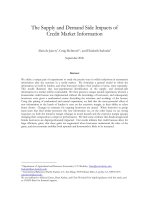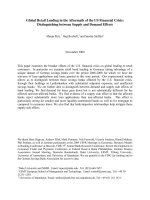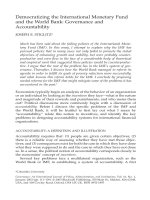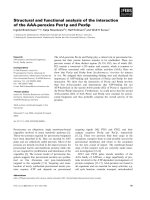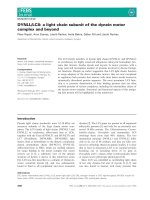The Logic of Individual Choice: The Foundation of Supply and Demand ppt
Bạn đang xem bản rút gọn của tài liệu. Xem và tải ngay bản đầy đủ của tài liệu tại đây (233.53 KB, 66 trang )
© 2003 McGraw-Hill Ryerson Limited
Chapter 8
Chapter 8
© 2003 McGraw-Hill Ryerson Limited.
8 - 2
◆
Economists have an answer to the
question of why people behave as they
do — self interest.
●
Economists' analysis of individual
choice does not deny individual
dierences.
© 2003 McGraw-Hill Ryerson Limited.
8 - 3
◆
A good beginning in understanding
individual choice is to focus on the
rational part of people's behavior.
© 2003 McGraw-Hill Ryerson Limited.
8 - 4
◆
Using the simple concept of self-
interest, two things determine what
people do:
●
The pleasure people get from doing
or consuming something.
●
The price of doing or consuming that
something.
© 2003 McGraw-Hill Ryerson Limited.
8 - 5
◆
Price is the market's tool to bring quantity
supplied equal to the quantity demanded.
◆
Changes in price provide incentives for
people to change what they are doing.
© 2003 McGraw-Hill Ryerson Limited.
8 - 6
◆
Economists start with a proposition that
individuals try to get as much pleasure
as possible out of life.
◆
The goods and services we consume
provide value (satisfaction) to us.
© 2003 McGraw-Hill Ryerson Limited.
8 - 7
◆
Individuals want to maximize the
amount of satisfaction they receive
through consuming goods and services.
© 2003 McGraw-Hill Ryerson Limited.
8 - 8
◆
Economists use the concept of utility—
the pleasure or satisfaction that one
gets from consuming a good or service.
◆
A util is a unit created by economists to
“measure” utility.
© 2003 McGraw-Hill Ryerson Limited.
8 - 9
◆
Utility serves as the basis of
economists' analysis of individual
choice.
◆
It is personal and individual.
◆
Utility cannot be compared across
individuals.
© 2003 McGraw-Hill Ryerson Limited.
8 - 10
◆
Total utility refers to the total
satisfaction one gets from consuming a
product.
© 2003 McGraw-Hill Ryerson Limited.
8 - 11
◆
Marginal utility refers to the
satisfaction one gets from the
consumption of one additional unit of a
product above and beyond what on has
consumed up to that point.
© 2003 McGraw-Hill Ryerson Limited.
8 - 12
◆
As additional units are consumed, marginal
utility decreases while total utility increases.
◆
When marginal utility is zero, total utility stops increasing.
◆
Beyond this point, marginal utility is negative and total
utility decreases.
© 2003 McGraw-Hill Ryerson Limited.
8 - 13
Number of
pizza slices
1
2
3
4
5
6
7
8
9
Total utility
14
26
36
44
50
54
56
56
54
Marginal utility
14
12
10
8
6
4
2
0
-2
!"#$ $"%
!"#$ $"%
© 2003 McGraw-Hill Ryerson Limited.
8 - 14
Total utility Marginal utility
Slices of pizza per hour
70
60
50
40
30
20
10
0
1 2 3 4 5 6 7 8 9
Slices of pizza per hour
16
14
12
10
8
6
4
2
0
-2
1 2 3 4 5 6 7 8 9
!"#$& $"%
!"#$& $"%
Total utility
Marginal utility
Utils Utils
© 2003 McGraw-Hill Ryerson Limited.
8 - 15
◆
The principle of diminishing marginal
utility states that, at some point, the
marginal utility received from each
additional unit of a good begins to
decrease with each additional unit
consumed.
© 2003 McGraw-Hill Ryerson Limited.
8 - 16
◆
This principle does not say you do not
enjoy consuming more of a good.
◆
It only states that as you consume more of the
good, you enjoy additional units less than you
enjoyed the initial units.
© 2003 McGraw-Hill Ryerson Limited.
8 - 17
'
'
◆
The analysis of rational choice begins
with the premise that rational individuals
want as much satisfaction as they can
get from their available income.
◆
Rational means that people prefer more
to less and will make choices that give
them as much satisfaction as possible.
© 2003 McGraw-Hill Ryerson Limited.
8 - 18
'
'
◆
In making choices, essentially what you
are doing is buying units of utility.
◆
Any choice (for the same amount of
money) that does not give you as many
units of utility as possible is an irrational
choice.
© 2003 McGraw-Hill Ryerson Limited.
8 - 19
'
'
◆
Since you want to get the most for your
money, you make those choices that
have the highest units of utility per
dollar spent.
© 2003 McGraw-Hill Ryerson Limited.
8 - 20
()
()
◆
Total utility is maximized when marginal
utility per dollar spent of two goods is
equal.
y
y
x
x
P
MU
P
MU
=
© 2003 McGraw-Hill Ryerson Limited.
8 - 21
()
()
◆
If:
y
y
x
x
P
MU
P
MU
>
◆
Choose to consume an additional unit of good x.
© 2003 McGraw-Hill Ryerson Limited.
8 - 22
()
()
◆
If:
y
y
x
x
P
MU
P
MU
<
◆
Choose to consume an additional unit of good y.
© 2003 McGraw-Hill Ryerson Limited.
8 - 23
()
()
◆
By substituting the marginal utilities and
prices of goods into these formulas, you
can always decide which good it makes
more sense to consume.
◆
Consume the one with the highest
marginal utility per dollar.
© 2003 McGraw-Hill Ryerson Limited.
8 - 24
()
()
*+&
*+&
◆
When the ratios of the marginal utility to
price of goods are equal, you are
maximizing utility.
© 2003 McGraw-Hill Ryerson Limited.
8 - 25
()
()
◆
If:
y
y
x
x
P
MU
P
MU
=
◆
You’re in equilibrium.
◆
You cannot increase your utility by
adjusting your choices.

